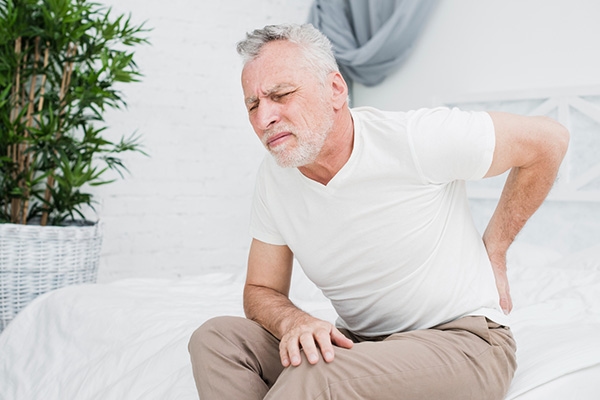One of the most annoying conditions to wake up with is lower back pain, especially if it lasts all day. Back discomfort is typically the result of poor posture or a misaligned spine. You also have a higher chance of waking up with annoying aches and pains if you sleep or stand in a tilted or bent position.
A trained orthopedist specializes in the medical and surgical treatment of musculoskeletal disorders and might do something to decrease or, at times, get rid of lower back and hip pain if it becomes chronic. We will cover more details in this blog. A specific high-quality pillow gives added support, reduces stress on the spine, and helps you maintain a better sleeping posture!
How Pillows Affect Your Lower Back Pain?
A good pillow may enhance your sleep in every way. Buying the right pillow may also help lessen back discomfort by providing additional spinal support and creating a cozy atmosphere.
Ensure your pillow maintains a neutral pelvic and spinal posture to relieve lower back pain. This keeps your back and spine straight and lowers your risk of developing back pain. To prevent lower back discomfort, your lower body and pelvic region must also be kept neutral or untwisted. Lower body pillows can assist with this sleeping posture.
Memory foam and specialty lower body pillows relieve pressure from your body, helping you avoid straining your muscles. As a result, you get a better night's sleep and a pain-free morning.
Physical therapy alone is not as effective in reducing back pain as physical therapy combined with a supporting pillow. Thus, it could be time to try a different pillow if you're suffering from pain from lower back ache.
Best Pillows for Lower Back Pain
Picking the best pillow for lower back pain becomes a necessity when you suffer every night and every morning. Now that we have discussed how a pillow can significantly affect your lower back, we need to jump into the types of pillows that are highly compatible and comfortable for your lower back and will help you prevent pain and uneasiness when you wake up:
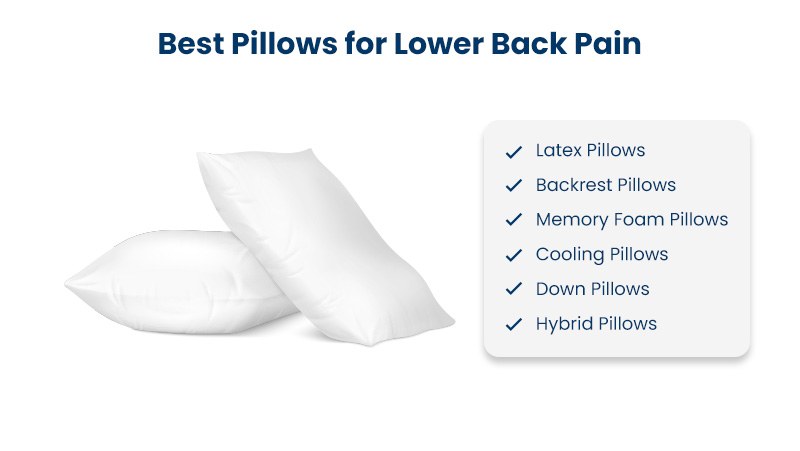
Latex Pillows
Latex pillows on the market are made of natural and synthetic rubber, which may be labeled as rubber instead of latex. These pillows frequently include shredded latex fill, which allows you to adjust the fit by adding or removing filler. Because of their adjustable nature, they are an appealing alternative for many people with back problems.
Backrest Pillows
A wedge-shaped backrest pillow is available to help you sit up straight. This pillow can help you sleep better at night by easing the tension on your back throughout the day. You'll also need a pillow to support your back during the night.
Memory Foam Pillows
Polyurethane is a synthetic substance used to make memory foam pillows. It undergoes a unique manufacturing procedure that imparts its recognizable bounce and sponginess. A memory foam pillow helps support your back's alignment since it molds to your body's specific shape.
Additionally, unlike ordinary pillows, which tend to compress over time, they will revert to their former shape. Because of this, they may be used to create beneficial knee pillows, which are placed between the knees when a person sleeps on their side.
Cooling Pillows
If you toss and turn during the night due to warmth, you should acquire a cooling pillow. There are many designs, but most consist of multiple layers, such as memory foam for support and a unique breathable/cooling substance in the middle.
Down Pillows
The softest and plushest pillows are most likely those made of down. Thus, this could be your best option if you've never enjoyed firm pillows. If you sleep on your stomach, down is the most comfortable option because this posture often requires a thinner, softer pillow. Additionally, down holds body heat reasonably well, so this may be your go-to pillow if you need extra warmth.
Hybrid Pillows
A hybrid pillow may offer both solid support and softness. This is a popular choice for people accustomed to sleeping with down pillows. However, it is less supportive than memory foam or a lower-body pillow.
What is Lower Back Pain?
The part of the back that begins below the ribs is known as the lower back or lumbar region. Most people have low back discomfort at some time in their lives. It's among the main reasons Americans skip work. Thankfully, things usually improve on their own. If not, your physician can assist you with several efficient therapies.
Types of Lower Back Pain?
Low back pain can be classified in a variety of ways; two popular categories are as follows:
Radical Pain
An impingement or inflammation on a spinal nerve root might result in this kind of discomfort. Radicular pain may radiate into the leg and buttocks along a nerve root pattern or dermatome. Its distinct pain is searing, electric, and acute and may be accompanied by weakness or numbness (sciatica). Usually, it just affects one side of the body.
Mechanical Pain
Mechanic, or axial pain, is the most prevalent cause of lower back pain. It generally originates from discomfort in the muscles, ligaments, joints (sacroiliac joints, facet joints), or bones surrounding the spine.
This discomfort is typical of the lower back, buttocks, and occasionally the upper legs. It is often brought on by loading the spine and might feel different. Lower back pain while sitting, standing, moving, twisting, or moving backward and forward can be felt more.
Furthermore, the kind of onset and length of lower back and abdominal pain symptoms are typically described as follows:
Acute Lower Back Pain
This pain is usually abrupt and lasts a few days or weeks. It is thought to be the body's natural reaction to an injury or tissue damage. The body recovers, and the discomfort eventually goes away.
Subacute Lower Back Pain
This pain, lasting anywhere from six weeks to three months, is typically mechanical (like a strained muscle or joint ache) but lasts longer. If the pain is severe enough to interfere with everyday activities, sleep, or work, a medical workup may now be considered, and it is advised in such cases.
Chronic lower Back Pain
Typically, chronic abdominal pain and back pain lasting more than three months; this kind of pain is usually severe, does not improve with over-the-counter medications, and needs a comprehensive medical evaluation to identify the precise cause of the pain.
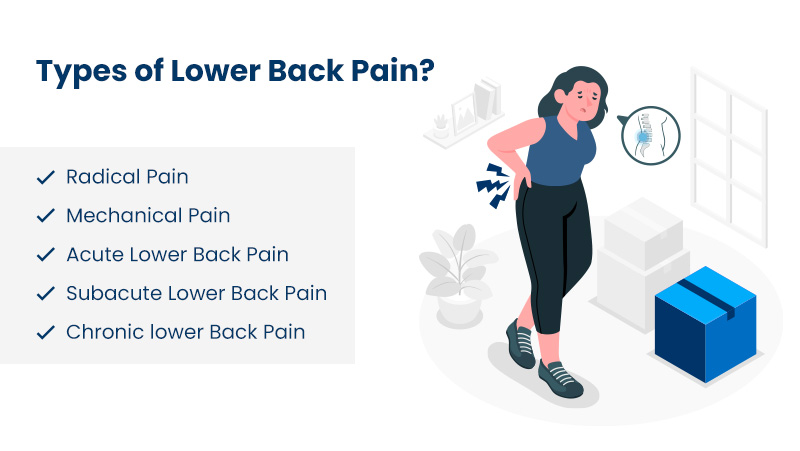
Symptoms of Lower Back Pain
Many other symptoms can accompany low back discomfort. It might be severe and incapacitating or minor and only bothersome. Abrupt or gradual onset is possible for low back pain, which may begin as a recurrent episode and worsen over time.
There are several ways in which symptoms might manifest themselves, contingent on the underlying source of the discomfort:
- Dull or aching pain limited to the lower back
- Sciatica is a tingling or numbing pain that radiates from the lower back to the backs of the thighs and occasionally into the lower legs or foot.
- Stiffness and spasms in the hips, pelvis, and lower back
Other Symptoms of Lower Back Pain
Stiffness
You might find it difficult to move or erect your back. It may take some time to get up from a seated position, and you may need to stretch or go for a stroll to help you loosen up. You can experience less range of motion.
Posture issues
Many people with back pain find standing up straight tricky. Instead of having their torsos in line with their spines, they can stand "crooked" or bowed. Their lower backs may appear flat rather than bent.
Spastic muscles
Following a strain, the lower back's muscles may contract erratically or spasm. Muscle spasms can result in severe discomfort and make standing, walking, or moving difficult or impossible.
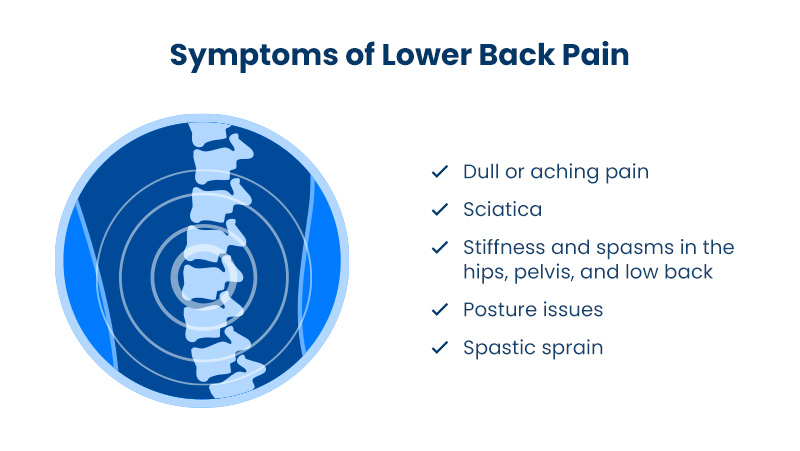
What Causes Lower Back Pain?
Various illnesses, injuries, and ailments can bring on back pain. Among them are:
Back sprains and strains
The most typical cause of back discomfort is a strain or sprain. Lifting something too heavy or unsafe risks hurting your muscles, tendons, or ligaments. Some individuals sneeze, cough, twist, or bend over, which puts tension on their backs.
Problems with structure
When the spinal column is too small to accommodate the spinal cord, a disorder known as spinal stenosis develops; anything squeezing the spinal cord might cause severe sciatic nerve pain and lower back pain. The curvature of the spine, known as scoliosis, can cause discomfort, stiffness, and trouble moving.
Disk issues
The vertebrae, or tiny spinal bones, are cushioned by disks. Disks can protrude from the spine and put pressure on a nerve. Moreover, they may tear - herniated disk. Discs may become flatter and provide less protection as they age - degenerative disk disease.
Fractures
The bones in the spine may shatter in an event such as a vehicle crash or a fall. Osteoporosis and spondylolysis are two disorders that raise the risk of fractures.
Spondylolisthesis
This disorder results in the slippage of the spine's vertebrae. Spondylolisthesis frequently causes discomfort in the legs and lower back.
Arthritis
The most frequent kind of arthritis that causes lower back discomfort is osteoarthritis—ankylosing spondylitis results in inflammation, stiffness, and pain in the lower back.
Disease
Infections, spinal tumors, and other cancers can bring on back discomfort. Other disorders might also cause back pain. Kidney stones and abdominal aortic aneurysms are two examples of this.
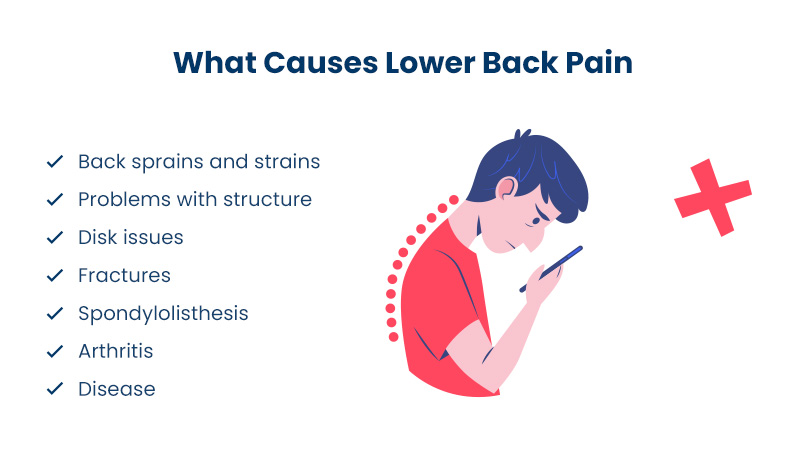
How Does Sleeping Position Affect Your Back?
An elongated spine or improper sleeping position are two significant causes of back discomfort. Your back and spine should remain straight and neutral for optimal comfort and sleep. However, sleep deprivation is a critical component that can increase lower back discomfort.
If you have trouble falling asleep or don't sleep, your body doesn't have enough time to relax and repair itself. Our bodies produce anti-inflammatory substances when we sleep. You'll probably have lower back pain without these beneficial substances since the inflammatory tissue is irreparable.
Even persistent pain has been connected in some studies to prolonged sleep deprivation. In other words, if you have lower back pain, you may set up a negative feedback loop in which you sleep in an uncomfortable position, have poor quality sleep, and then experience worsening back pain as a result of not getting enough sleep.
How Common is Lower Back Pain?
According to the Global Burden of Disease survey, lower back pain is the primary cause of disability worldwide. Many people will have lower back pain at some time in their lives due to its extreme commonness. It is among the most common musculoskeletal disorders in the globe.
An estimated 80% of individuals will experience lower back discomfort at some point. The discomfort can range in severity from occasional, minor discomfort to persistent, severe pain that makes everyday tasks difficult.
The chance of developing lower back pain can be influenced by several factors, including age, lifestyle, employment, level of physical fitness, and underlying medical disorders. While there isn't a significant difference in the occurrence of lower back pain between genders, some studies suggest that female lower back pain is a much more common phenomenon, especially during certain stages of life, like pregnancy and menopause.
Pregnancy back pain is widespread since the entire weight of the baby is created at the center of the baby and the back all the pressure to support it, which eventually develops constant discomfort for the expectant mothers. Try Eli & Elm’s Pregnancy Body Pillow, which is innovative for superior back, pelvic, and belly support.
How to Sleep with Your Pillow to Avoid Lower Back Pain?
Place a pillow between your knees as you sleep on your side
Try turning to your side if laying flat on your back doesn't seem comfortable:
- Let your left or right shoulder and the remainder of that side of your body touch the mattress.
- Put a pillow in between your legs.
- Consider placing a small pillow between your waist and the mattress for additional support.
You should fight the impulse to sleep on the same side of the bed regardless of whether you use two or just one pillow. Overdoing it can lead to problems such as scoliosis and muscular imbalance.
Benefit
Sleeping on your side alone won't help. The secret is to use the pillow between your knees. The pillow will help align your hips, pelvis, and spine.
Sleep in a fetal posture on your side
Try sleeping on your side, curled into a fetal posture, if you have a herniated disc:
- Slowly turn over onto your side to reduce lower back pain when lying on your back.
- Curl your body softly toward your knees and tuck your knees toward your chest.
- Remember to alternate sides periodically to avoid any imbalances.
Benefits
Your spine's discs are supple pillows located between each vertebrae. When a disc herniates, a portion pushes out of its natural area, resulting in neuropathic pain, weakness, and other symptoms. Placing your body in a fetal posture allows your vertebrae to expand.
Sleep with a pillow under your stomach
You may have heard that sleeping on your stomach aggravates back discomfort. This is accurate as it may cause neck pain, too, sometimes to the extent of cervical pain. You don't need to push yourself into a different position if you find yourself resting on your stomach. Rather:
- Put a pillow beneath your lower abdomen and pelvis to take some of the strain off your back.
- Depending on how this posture feels, you may or may not want to place a pillow under your head.
Benefits
Stomach sleeping with a pillow may be especially beneficial for those with degenerative disc conditions. The pillow might release any strain on the area between your discs.
Place a pillow under your knees when lying on your back
The ideal sleeping position for specific individuals to reduce back discomfort may be on their backs:
- Lie down on your back.
- Stack a pillow beneath your knees and maintain a neutral spine. The pillow plays a crucial role in maintaining the natural curvature of your lower back.
- You may also tuck a little towel under the small of your back for extra support.
Benefits
While sleeping on your back, your weight is equally distributed across your body's most significant possible region. Thus, you put less stress on your pressure spots. Better alignment of your internal organs and spine is also possible.
Take a nap in a reclining position on your back
Do you find that sleeping on a chair is most comfortable? Even though it might not be ideal for back discomfort, sleeping in a chair can help if you have isthmic spondylolisthesis.
Consider investing in an adjustable bed to get the finest alignment and support when sleeping in this position.
Benefits
A disorder known as isthmic spondylolisthesis occurs when a vertebra slides over the one underneath it. Your back may benefit from reclining since it makes your thighs and trunk at an angle. Your spine will feel less pressure at this angle.
When to Seek Professional Care?
Back discomfort from intense activity or heavy lifting is frequently the result of muscle tension. However, occasionally, it results from tiny jelly-filled disks designed to protect the intervertebral discs. One of these disks may press against a nerve if it swells or fractures. Pain radiates down one leg from the buttock when the sciatic nerve is involved. This is, as we hear, sciatica.
Consult a medical practitioner if you experience back discomfort following an accident or fall. This also applies to back pain associated with leg weakness, fever, dyspepsia, or discomfort when coughing or urinating.

